给女朋友讲ActiveMQ是啥?
1 ActiveMQ是啥
ActiveMQ 就是一个 消息中间件 ,市面上现在有很多的消息中间件开源产品,比如,RocketMQ、RabbitMQ、Kafka等。
拿一个简单的比喻来说,消息中间件就是一个中转站,在程序中加的一个中转站,有了这样一个类似 快递 的存储站点,可以大大的减轻 物流 的压力,而对应到程序中,也就是减轻了程序的压力。
另外不得不说的是,ActiveMQ是遵从 JMS 规范的消息中间件,那么什么是 JMS 规范呢?
JMS 规范
JMS是java的消息服务,JMS的客户端之间可以通过JMS服务进行异步的消息传输。
消息模型
- Point-to-Point(P2P),点对点
- P2P模式图
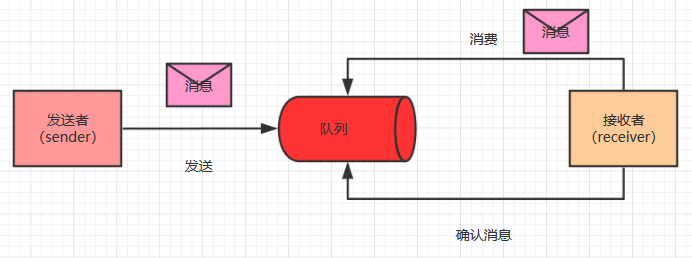
如上图,有几个需要了解的概念, 发送者、接收者、消息队列 。
在点对点模型中,一般消息由发送者将消息发送到 消息队列 中,然后,接收者从消息队列中消费消息,消息被消费者消费之后,消息就不存在了。
- Publish/Subscribe(Pub/Sub),发布订阅模型
- Pub/Sub模式图
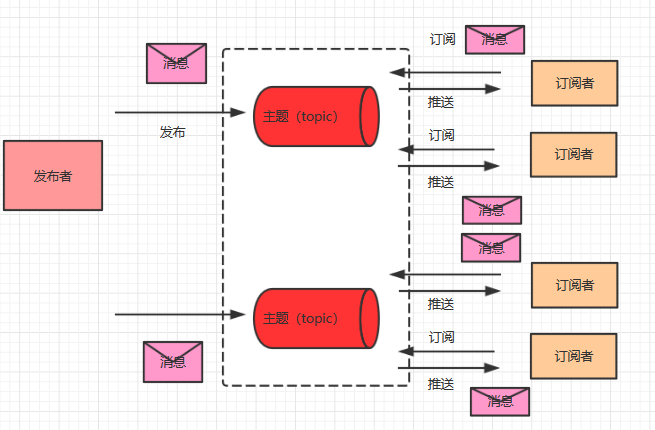
如上图,有下面几个概念, 主题、发布者、订阅者 。
在 发布订阅 模型中,发布者通常将消息发布到 主题 (topic)中,然后,订阅者通过订阅主题来消费消息,与 P2P 模型不同的是,发布订阅模型的消息是可以被多次消费的!
两种模式的区别
1、 P2P
在发送者和接收者之间 没有时间上的依赖性
,也就是说发送者发送了消息之后,不管接收者有没有运行,不会影响消息发送到队列,而 Pub/Sub
模式 有时间上的依赖性
,消费者必须先订阅主题,才能够消费消息。
2、 P2P
模式的每个消息只能有一个消费者,消费完了消息就不存在了, Pub/Sub
模式可以有多个消费者。
2 为什么需要使用消息中间件
到这里我就不得不讲一个 小故事 了!
小明、小李和小白都是在一个项目组的 Java 开发人员,但是呢,他们的团队比较小,只有几个开发人员,而他们正在开发一个项目,这个项目比较庞大,所以,项目负责人就考虑到项目进度,给他们每个人都分一个模块单独开发,这样就能够加快项目的进度了。
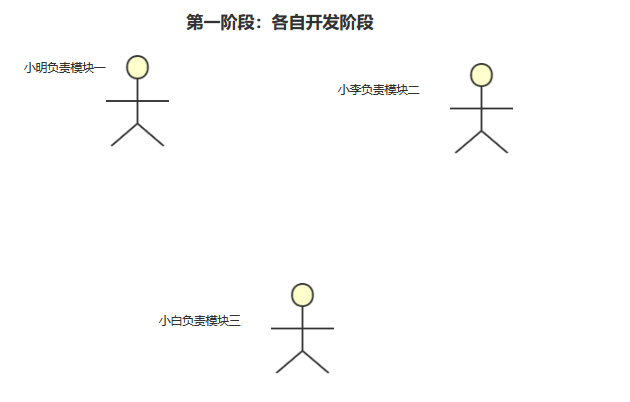
然而,万万没有想到的是,当项目开发到一定阶段的时候,小明、小李和小白各自负责的模块都需要项目调用数据了,但是呢,现在问题来了,每次 小白 向 小明 需要数据的时候,小明总是要改接口来满足小白的需求,而且还会担心 小明的系统会不会出问题 ,如果出了问题就调用不了怎么办?这样就总是耽误项目的进度,小李那边也是出现了这种问题!
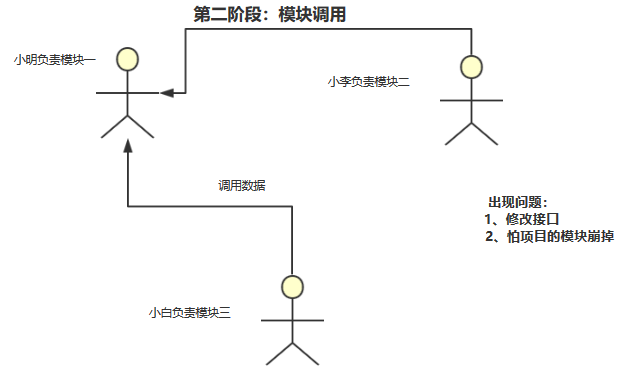
于是, 小明 就想了个办法,如果在各个模块之间再 加一个模块 ,用来处理数据,比如一个 队列来存数据 ,每次就把数据丢到那个模块中去,这样就不用担心那个问题啦。小明是不是很聪明!
其实,小明没有做足够的调查,他说的这个模块,就是 ActiveMQ 的作用所在啦。
也就是 降低模块与模块之间的耦合度 ,达到 解耦 的目的!
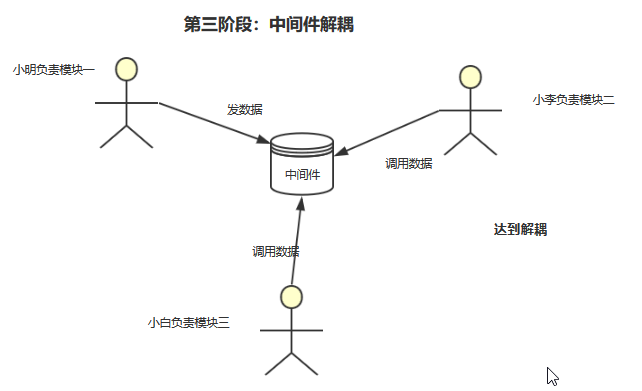
然后,他们又遇到了一个问题,他们在开发一个用户注册模块的时候,是 先注册,然后写入数据库,然后再发送邮件或者短信通知用户 ,但是,他们发现这样的系统速度很慢!

后来,他们发现了 消息中间件 后,改造了一下,变成了下面的模式。
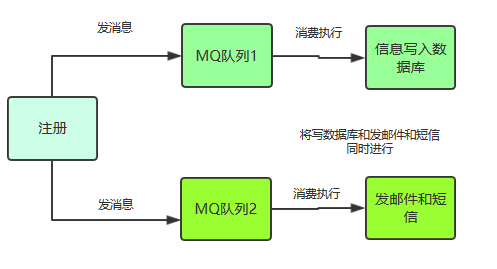
他们也发现了,这就是消息中间件带来的 异步执行 的优势!
系统速度杠杠的!
后来,小明、小李和小白开发的系统呢上线了,但是,公司业快速发展,当流量大的时候,系统的数据调用总是负荷不了,出现宕机的问题,没办法,只能再改代码了!
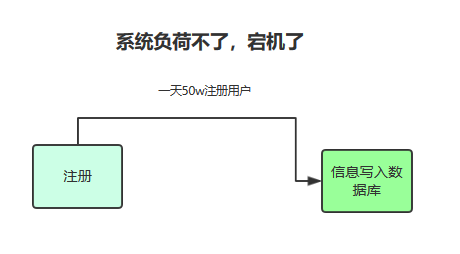
他们灵机一动,前面都用了消息中间件了,但是没有发现另外一个功能,我们可以加入消息中间件, 控制每次消费消息的数量 ,保证系统不会宕机,剩下的消息在系统流量小的时候再定时执行不就可以了。简直不要太好!
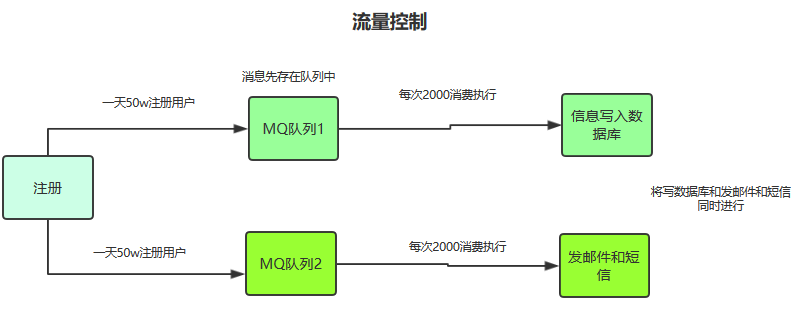
小明、小李和小白经过这个系统的开发,终于明白了消息中间件的优势了!
3 安装使用
3.1 下载
到下面的官网地址下载,包括linux和Windows的不同版本。
- https://activemq.apache.org/c...
3.2 解压使用
windows使用方法
首先,解压到一个自己的目录,ActiveMQ目录如下;
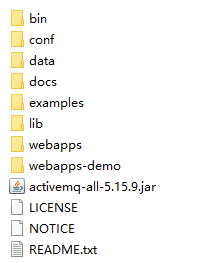
进入到对应的 bin 目录;
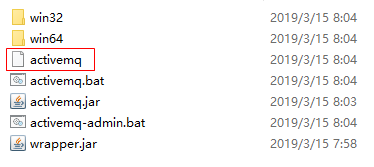
里面有一个 activemq 的可执行文件,打开 cmd,执行: activemq start
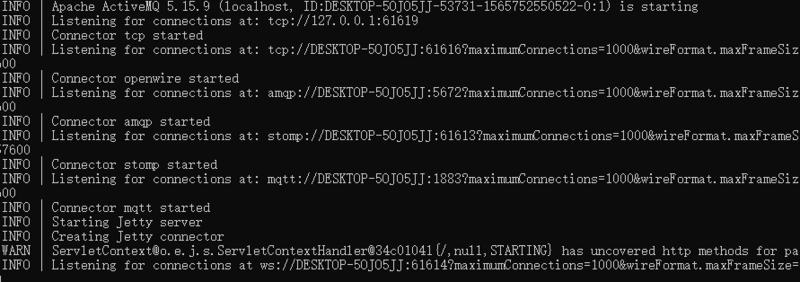
成功启动了!
关闭;
activemq stop
linux 使用方法
解压到指定目录;
sudo tar zxvf activemq-x.x.x-bin.tar.gz
进入到 bin 目录,执行下面命令;
./activemq start
关闭;
./activemq stop
后台管理界面
启动成功之后,可以输出 http://localhost:8161/admin/
查看 ActiveMQ 的后台管理界面,用户名和密码都为 admin
。
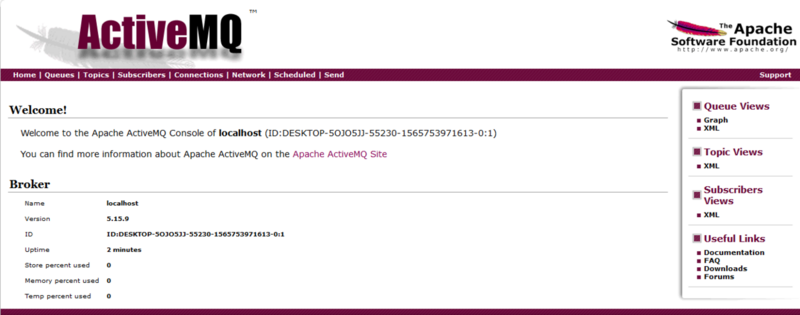
ok,到这里,ActiveMQ的安装和基本使用应该没有问题了,接下来,我们使用 ActiveMQ 的 Java API 从一个入门实例开始讲起!
4 ActiveMQ入门程序
4.1 前提条件
在开始之前,先申明一下需要的 Java 环境的配置,相关配置自行解决哦!
- Java JDK1.7 以上
- Maven 3.0 以上
- 开发工具 IDEA
4.2 带你入门
step1:导入 Maven 相关依赖;
<build>
<plugins>
<plugin>
<groupId>org.apache.maven.plugins</groupId>
<artifactId>maven-compiler-plugin</artifactId>
<configuration>
<source>8</source>
<target>8</target>
</configuration>
</plugin>
</plugins>
</build>
<properties>
<project.build.sourceEncoding>UTF-8</project.build.sourceEncoding>
<spring.version>4.3.10.RELEASE</spring.version>
</properties>
<dependencies>
<dependency>
<groupId>org.apache.activemq</groupId>
<artifactId>activemq-all</artifactId>
<version>5.15.0</version>
</dependency>
<dependency>
<groupId>org.springframework</groupId>
<artifactId>spring-jms</artifactId>
<version>${spring.version}</version>
</dependency>
<dependency>
<groupId>org.apache.commons</groupId>
<artifactId>commons-pool2</artifactId>
<version>2.6.2</version>
</dependency>
<dependency>
<groupId>junit</groupId>
<artifactId>junit</artifactId>
<version>4.12</version>
</dependency>
<dependency>
<groupId>org.springframework</groupId>
<artifactId>spring-test</artifactId>
<version>4.2.5.RELEASE</version>
</dependency>
</dependencies>
step2:创建 发送端 类;
/**
* @ClassName JmsSender
* @Description
* @Author 欧阳思海
* @Date 2019/8/13 16:39
* @Version 1.0
**/
public class JmsSender {
public static void main(String[] args) {
ConnectionFactory connectionFactory = new ActiveMQConnectionFactory("tcp://localhost:61616");
Connection connection = null;
try {
connection = connectionFactory.createConnection();
connection.start();
Session session = connection.createSession(Boolean.FALSE, Session.CLIENT_ACKNOWLEDGE);
Destination destination = session.createQueue("queue");
MessageProducer producer = session.createProducer(destination);
TextMessage textMessage = session.createTextMessage("hello activemq");
producer.send(textMessage);
//session.commit();
session.close();
} catch (JMSException e) {
e.printStackTrace();
} finally {
if (connection != null) {
try {
connection.close();
} catch (JMSException e) {
e.printStackTrace();
}
}
}
}
}
上面的代码创建了一个消息发送者,步骤如下:
1、创建ActiveMQ实现的JMS规范的实现类 ActiveMQConnectionFactory
的对象 connectionFactory
,并且给定参数ActiveMQ的服务地址;
2、由 connectionFactory
调用方法 createConnection
创建连接 connection
对象;
3、由 connection
对象调用 createSession
方法创建 session
会话对象;
4、有了 session
对象之后,就可以发送者、队列或者主题了,这里创建队列, session.createQueue("queue")
,并给定了队列名称为 queue
。
5、 session
对象通过方法 createProducer
创建生产者,并且创建消息 session.createTextMessage("hello activemq")
;
6、生产者调用 send
的方法发送消息, producer.send(textMessage)
;
通过上面的步骤就可以将消息发送到队列中了,接着只要等待消费者消费消息即可,消息消费后,消息就消失了。
通过上面的讲解,也将JMS的主要的接口都概括了,包括: ConnectionFactory(连接工厂)、Session(会话)、Connection(连接) ;
step3:创建 消费端 类;
/**
* @ClassName JmsReceiver
* @Description
* @Author 欧阳思海
* @Date 2019/8/13 16:47
* @Version 1.0
**/
public class JmsReceiver {
public static void main(String[] args) {
ConnectionFactory connectionFactory = new ActiveMQConnectionFactory("tcp://localhost:61616");
Connection connection = null;
try {
//创建连接
connection = connectionFactory.createConnection();
connection.start();
Session session = connection.createSession(Boolean.TRUE, Session.AUTO_ACKNOWLEDGE);
//创建队列(如果队列已经存在则不会创建,queue是队列名称)
//destination表示目的地
Destination destination = session.createQueue("queue");
//创建消息接收者
MessageConsumer consumer = session.createConsumer(destination);
TextMessage textMessage = (TextMessage) consumer.receive();
System.out.println(textMessage.getText());
session.commit();
session.close();
} catch (JMSException e) {
e.printStackTrace();
} finally {
if (connection != null) {
try {
connection.close();
} catch (JMSException e) {
e.printStackTrace();
}
}
}
}
}
消费者和生产者的差别不大,前面的 创建工厂、创建连接、创建会话
对象和生产者一样,区别在于, session.createConsumer(destination)
通过 session
创建消费者,然后,调用 receive
方法接受消息。
运行 发送端 ,查看后台管理界面,点击 Queues 选项,发现有一个 入队 的消息,并且没有 出队列 ;

运行 接收端 ;

再查看后台管理界面,消息被消费了;

5 ActiveMQ整合Spring
这一部分花了挺多时间琢磨的,首先是应为在实际的开发中,我们整合Spring来开发项目是最多的一种方式,这一块如果可以学透的话,对于项目开发是非常有好处的,出于这个出发点,尽可能的把相关的知识讲解的全面一些。
首先,这一部分分为以下 三个部分 来讲解。
- 不使用 Spring 配置文件方式
- 使用 Spring 配置文件方式
- 注解方式(0配置)
5.1 前提条件
- JDK 1.7 以上
- Maven 3.0 以上
- Spring 4.3.1 ,或者以上版本
- ActiveMQ 5.15.9 目前最新稳定版本
项目结构
这次搭建的项目是一个子模块聚合的项目,结构如下;
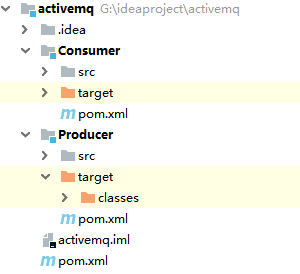
这个聚合的项目分为 生产者(Producer) 和 消费者(Consumer) 两个子模块。
导入 Maven 依赖
<properties>
<project.build.sourceEncoding>UTF-8</project.build.sourceEncoding>
<spring.version>4.3.10.RELEASE</spring.version>
</properties>
<dependencyManagement>
<dependencies>
<dependency>
<groupId>org.apache.activemq</groupId>
<artifactId>activemq-all</artifactId>
<version>5.15.9</version>
</dependency>
<dependency>
<groupId>org.springframework</groupId>
<artifactId>spring-jms</artifactId>
<version>${spring.version}</version>
</dependency>
<dependency>
<groupId>org.apache.commons</groupId>
<artifactId>commons-pool2</artifactId>
<version>2.6.2</version>
</dependency>
<dependency>
<groupId>junit</groupId>
<artifactId>junit</artifactId>
<version>4.12</version>
</dependency>
<dependency>
<groupId>org.springframework</groupId>
<artifactId>spring-test</artifactId>
<version>4.2.5.RELEASE</version>
</dependency>
</dependencies>
</dependencyManagement>
温馨提示
由于我这里使用的是子模块聚合的方式,所以,如果你不是这种方式的项目,直接给出各个依赖的版本在你的项目中即可!
5.2 不使用 Spring 配置文件方式
这一节的讲解中,我们将采用不使用 Spring 的配置文件的方式,Maven 的相关依赖在上面已经给出,请参考上一节的内容。
生产者(Producer)
首先,我们来看一下生产者端,生产者端主要负责发送消息到 Broker
中,发送的 目的地(Destination)
可以分为 队列(Queue)
和 主题(Topic)
,下面,我们就看看如何 不采用 Spring 配置文件的方式发送消息
。
public static void main(String[] args) {
ConnectionFactory cf = new ActiveMQConnectionFactory("tcp://localhost:61616");
Connection connection = null;
try {
connection = cf.createConnection();
connection.start();
Session session = connection.createSession(Boolean.TRUE, Session.AUTO_ACKNOWLEDGE);
Queue destination = session.createQueue("queue2");
JmsQueueSenderWithNotXml jmsQueueSender = new JmsQueueSenderWithNotXml();
jmsQueueSender.setConnectionFactory(cf);
jmsQueueSender.setQueue(destination);
jmsQueueSender.simpleSend();
jmsQueueSender.sendWithConversion();
} catch (JMSException e) {
e.printStackTrace();
}
}
private JmsTemplate jmsTemplate;
private Queue queue;
public void setConnectionFactory(ConnectionFactory cf) {
this.jmsTemplate = new JmsTemplate(cf);
}
public void setQueue(Queue queue) {
this.queue = queue;
}
/*
* @Author 欧阳思海
* @Description 发送简单消息
* @Date 15:45 2019/8/16
* @Param []
* @return void
**/
public void simpleSend() {
this.jmsTemplate.send(this.queue, new MessageCreator() {
public Message createMessage(Session session) throws JMSException {
return session.createTextMessage("hello queue world");
}
});
System.out.println("发送成功!");
}
/*
* @Author 欧阳思海
* @Description 发送map类型的消息
* @Date 15:46 2019/8/16
* @Param []
* @return void
**/
public void sendWithConversion() {
Map map = new HashMap();
map.put("Name", "sihai");
map.put("Age", new Integer(18));
jmsTemplate.convertAndSend("Queue3", map, new MessagePostProcessor() {
public Message postProcessMessage(Message message) throws JMSException {
message.setIntProperty("num", 189);
message.setJMSCorrelationID("00001");
return message;
}
});
System.out.println("发送成功!");
}
step1:上面是生产者端的所有代码示例,在这个示例中,我们首先通过下面的代码 设置好ConnectionFactory 和Queue
,并且调用 JmsTemplate
Spring提供的工具类提供两个发送消息的方法 。
private JmsTemplate jmsTemplate;
private Queue queue;
public void setConnectionFactory(ConnectionFactory cf) {
this.jmsTemplate = new JmsTemplate(cf);
}
public void setQueue(Queue queue) {
this.queue = queue;
}
/*
* @Author 欧阳思海
* @Description 发送简单消息
* @Date 15:45 2019/8/16
* @Param []
* @return void
**/
public void simpleSend() {
this.jmsTemplate.send(this.queue, new MessageCreator() {
public Message createMessage(Session session) throws JMSException {
return session.createTextMessage("hello queue world");
}
});
System.out.println("发送成功!");
}
/*
* @Author 欧阳思海
* @Description 发送map类型的消息
* @Date 15:46 2019/8/16
* @Param []
* @return void
**/
public void sendWithConversion() {
Map map = new HashMap();
map.put("Name", "sihai");
map.put("Age", new Integer(18));
jmsTemplate.convertAndSend("Queue3", map, new MessagePostProcessor() {
public Message postProcessMessage(Message message) throws JMSException {
message.setIntProperty("num", 189);
message.setJMSCorrelationID("00001");
return message;
}
});
System.out.println("发送成功!");
}
step2:使用Main方法, 设置ConnectionFactory和Queue对象 ,接着,调用发送方法发送消息。
public static void main(String[] args) {
ConnectionFactory cf = new ActiveMQConnectionFactory("tcp://localhost:61616");
Connection connection = null;
try {
connection = cf.createConnection();
connection.start();
Session session = connection.createSession(Boolean.TRUE, Session.AUTO_ACKNOWLEDGE);
Queue destination = session.createQueue("queue2");
JmsQueueSenderWithNotXml jmsQueueSender = new JmsQueueSenderWithNotXml();
jmsQueueSender.setConnectionFactory(cf);
jmsQueueSender.setQueue(destination);
jmsQueueSender.simpleSend();
jmsQueueSender.sendWithConversion();
} catch (JMSException e) {
e.printStackTrace();
}
}
step2:接着,我们 运行 上面的代码,输出下面结果,再看一下 ActiveMQ的控制台 ,看看有没有消息发送成功。


发现有一条挂起的消息和入队列的消息,说明发送成功!
消费者(Consumer)
对于消费者,在这一节先不展开讲解,可以先参考上面的 入门程序的消费端 的代码消费消息,接下来的方式再讲解消费端的消费消息。
5.3 使用 Spring 配置文件方式
上面一节中,讲解了不使用 Spring 配置的方式如何发送消息,主要是想让大家了解一下其中的原理,这一节中,将使用 Spring 配置的方式讲解,这种方式在实际的开发中还是用的比较多的。
生产者(Producer)
既然是配置文件的方式,那么,首先,不得不讲如何进行xml配置了。
step1:xml配置文件
<?xml version="1.0" encoding="UTF-8"?>
<beans xmlns="http://www.springframework.org/schema/beans"
xmlns:xsi="http://www.w3.org/2001/XMLSchema-instance"
xmlns:jms="http://www.springframework.org/schema/jms"
xsi:schemaLocation="
http://www.springframework.org/schema/beans https://www.springframework.org/schema/beans/spring-beans.xsd
http://www.springframework.org/schema/jms https://www.springframework.org/schema/jms/spring-jms.xsd">
<bean id="connectionFactory" class="org.apache.activemq.pool.PooledConnectionFactory" destroy-method="stop">
<property name="connectionFactory">
<bean class="org.apache.activemq.ActiveMQConnectionFactory">
<property name="brokerURL">
<value>tcp://localhost:61616</value>
</property>
</bean>
</property>
<property name="maxConnections" value="50"/>
</bean>
<bean id="destination" class="org.apache.activemq.command.ActiveMQQueue">
<constructor-arg index="0" value="spring-queue"/>
</bean>
<!--<bean id="destinationTopic" class="org.apache.activemq.command.ActiveMQTopic">
<constructor-arg index="0" value="spring-topic"/>
</bean>-->
<bean id="jmsTemplate" class="org.springframework.jms.core.JmsTemplate">
<property name="connectionFactory" ref="connectionFactory"/>
<property name="defaultDestination" ref="destination"/>
<property name="messageConverter">
<bean class="org.springframework.jms.support.converter.SimpleMessageConverter"/>
</property>
</bean>
</beans>
在上面的配置中,首先,需要配置 connectionFactory
(对应不使用配置的connectionFactory对象),然后,需要配置 destination
(对应不使用配置的destination),在这里使用的是向队列发送消息,也可以使用主题(Topic),最后,配置 Spring 提供的 jmsTemplate
模板类。
step2:使用Main方法运行
public static void main(String[] args) {
ApplicationContext application = new FileSystemXmlApplicationContext("G://ideaproject//activemq//Producer//src//main//resources//service-jms.xml");
JmsTemplate jmsTemplate = (JmsTemplate) application.getBean("jmsTemplate");
for (int i = 0; i < 10; i++) {
int finalI = i;
jmsTemplate.send((session) -> {
TextMessage textMessage = session.createTextMessage();
textMessage.setText("first message" + finalI);
return textMessage;
});
}
}
在上面的代码中,调用了 JmsTemplate
的 send
方法发送消息。运行之后,就成功发送消息了,这种方式还是简洁不少的。
温馨提示
上面我使用的是 FileSystemXmlApplicationContext
获取xml配置文件,除此之外,你也可以使用 ClassPathXmlApplicationContext
来获取。
消费者(Consumer)
在上一节中,没有讲解消费者,在这一节中,将重点讲解。
step1:首先,我们还是需要配置xml文件
<?xml version="1.0" encoding="UTF-8"?>
<beans xmlns="http://www.springframework.org/schema/beans"
xmlns:context="http://www.springframework.org/schema/context"
xmlns:xsi="http://www.w3.org/2001/XMLSchema-instance"
xmlns:amq="http://activemq.apache.org/schema/core"
xmlns:jms="http://www.springframework.org/schema/jms"
xsi:schemaLocation="http://www.springframework.org/schema/beans
http://www.springframework.org/schema/beans/spring-beans-4.1.xsd
http://www.springframework.org/schema/context
http://www.springframework.org/schema/context/spring-context-4.1.xsd
http://www.springframework.org/schema/jms
http://www.springframework.org/schema/jms/spring-jms-4.1.xsd
http://activemq.apache.org/schema/core
http://activemq.apache.org/schema/core/activemq-core-5.8.0.xsd">
<!--连接工厂-->
<bean id="connectionFactory" class="org.apache.activemq.pool.PooledConnectionFactory" destroy-method="stop">
<property name="connectionFactory">
<bean class="org.apache.activemq.ActiveMQConnectionFactory">
<property name="brokerURL">
<value>tcp://localhost:61616</value>
</property>
</bean>
</property>
<property name="maxConnections" value="50"/>
</bean>
<!--配置队列-->
<bean id="destination" class="org.apache.activemq.command.ActiveMQQueue">
<constructor-arg index="0" value="queue2"/>
</bean>
<!-- 配置主题(topic)-->
<!-- <bean id="destinationTopic" class="org.apache.activemq.command.ActiveMQTopic">
<constructor-arg index="0" value="spring-topic"/>
</bean>-->
<!--配置spring的jms模板-->
<bean id="jmsTemplate" class="org.springframework.jms.core.JmsTemplate">
<property name="connectionFactory" ref="connectionFactory"/>
<property name="defaultDestination" ref="destination"/>
<property name="messageConverter">
<bean class="org.springframework.jms.support.converter.SimpleMessageConverter"/>
</property>
</bean>
<!-- 消息监听器 -->
<!--<bean id="messageListener" class="com.sihai.activemq.listener.MyMessageListener"/>-->
<bean id="messageListener" class="com.sihai.activemq.listener.MySessionAwareMessageListener"></bean>
<!--jta事务-->
<!--<bean id="transactionManager" class="org.springframework.transaction.jta.JtaTransactionManager"/>-->
<!-- 消息监听器容器 -->
<bean id="jmsContainer" class="org.springframework.jms.listener.DefaultMessageListenerContainer">
<property name="connectionFactory" ref="connectionFactory"/>
<property name="destination" ref="destination"/>
<property name="messageListener" ref="messageListener"/>
<!--配置本地资源事务-->
<!--<property name="sessionTransacted" value="true"/>-->
<!--配置jta事务-->
<!--<property name="transactionManager" ref="transactionManager"/>-->
</bean>
<!--<!– 监听注解支持 –>
<jms:annotation-driven />-->
</beans>
最前面的配置和生产者是一样的,需要配置 connectionFactory
(对应不使用配置的connectionFactory对象),然后,需要配置 destination
(对应不使用配置的destination)。
区别在于,消费者端需要配置一个 消息监听器容器 ,如下。
<!-- 消息监听器 -->
<!--<bean id="messageListener" class="com.sihai.activemq.listener.MyMessageListener"/>-->
<bean id="messageListener" class="com.sihai.activemq.listener.MySessionAwareMessageListener"></bean>
<!--jta事务-->
<!--<bean id="transactionManager" class="org.springframework.transaction.jta.JtaTransactionManager"/>-->
<!-- 消息监听器容器 -->
<bean id="jmsContainer" class="org.springframework.jms.listener.DefaultMessageListenerContainer">
<property name="connectionFactory" ref="connectionFactory"/>
<property name="destination" ref="destination"/>
<property name="messageListener" ref="messageListener"/>
<!--配置本地资源事务-->
<!--<property name="sessionTransacted" value="true"/>-->
<!--配置jta事务-->
<!--<property name="transactionManager" ref="transactionManager"/>-->
</bean>
那么这个怎么配置呢?请接着看。
step2:消息监听器容器配置
首先,我们需要写一个类,实现 MessageListener
接口,然后实现一个名为 onMessage
的方法,通过这个方法就可以 监听是否有消息,有消息就消费
。
/**
* @ClassName MyMessageListener
* @Description 消息消费监听器实现
* @Author 欧阳思海
* @Date 2019/8/13 20:39
* @Version 1.0
**/
@Component
public class MyMessageListener implements MessageListener {
@Override
public void onMessage(Message message) {
if (message instanceof TextMessage) {
try {
System.out.println(((TextMessage) message).getText());
}
catch (JMSException ex) {
throw new RuntimeException(ex);
}
}
else {
throw new IllegalArgumentException("Message must be of type TextMessage");
}
}
}
如此,配置就完成了。
step3:启动spring容器,运行。
/*
* @Author 欧阳思海
* @Description xml配置方式获取消息
* @Date 18:09 2019/8/16
* @Param []
* @return void
**/
@Test
public void test_01() throws IOException {
ClassPathXmlApplicationContext application = new ClassPathXmlApplicationContext("G://ideaproject//activemq//Consumer//src//main//resources//service-jms.xml");
/*JmsTemplate jmsTemplate = (JmsTemplate) application.getBean("jmsTemplate");
String msg = (String) jmsTemplate.receiveAndConvert();
System.out.println(msg);*/
System.in.read();
}
在上面的代码中, System.in.read()
,这个作用就是一直等待,有消息就消费。

step4:开启消息监听器事务
在消息处理的过程中是可以开启事务的,如果出现处理失败的情况,就会回滚。在 消息监听容器
当中可以配置一个 属性是sessionTransacted的本地事务
,如果 value
为 true
,就代表开启本地事务。具体配置如下:
<!-- 消息监听器容器 -->
<bean id="jmsContainer" class="org.springframework.jms.listener.DefaultMessageListenerContainer">
<property name="connectionFactory" ref="connectionFactory"/>
<property name="destination" ref="destination"/>
<property name="messageListener" ref="messageListener"/>
<!--配置本地资源事务-->
<property name="sessionTransacted" value="true"/>
</bean>
消息监听器容器
上面的消费者的讲解中,其实,最重要的就是 消息监听器容器配置 了,这一部分,我们就详细的讲解一下 消息监听器容器 的配置方法。
1 实现MessageListener接口
这种方式就是上面的实例使用的方式,先看看这个接口。
public interface MessageListener {
void onMessage(Message var1);
}
这个接口很简单,只有一个方法 onMessage
,通过拿到 Message
参数读取消息,这里就不再多说了。
2 实现SessionAwareMessageListener接口
这个接口平时很少用到,但是,其实是有这个接口可以实现的,这个接口和上面的 MessageListener
接口有点不一样,这个接口是 Spring
提供的。
public interface SessionAwareMessageListener<M extends Message> {
void onMessage(M var1, Session var2) throws JMSException;
}
另外,你可以看到,这个接口提供的是一个泛型接口,可以是 M extends Message
这个类型,同时,实现的方式 onMessage
,还多了一个 Session
参数,可以在获取消息的同时处理 Session
。
使用实例
/**
* @ClassName MySessionAwareMessageListener
* @Description 实现SessionAwareMessageListener的消息监听器
* @Author 欧阳思海
* @Date 2019/8/16 16:02
* @Version 1.0
**/
public class MySessionAwareMessageListener implements SessionAwareMessageListener {
@Override
public void onMessage(Message message, Session session) throws JMSException {
if (message instanceof TextMessage) {
try {
System.out.println(((TextMessage) message).getText());
}
catch (JMSException ex) {
throw new RuntimeException(ex);
}
}
else {
throw new IllegalArgumentException("Message must be of type TextMessage");
}
}
}
5.4 注解方式(0配置)
前面已经介绍了两种方式,分别是 不使用xml配置方式 和 使用xml配置的方式 ,但是,由于现在微服务的兴起,约定优于配置是现在的一种趋势,所以,在这一节中,我们使用 注解的方式 来处理。
生产者(Producer)
由于使用注解的方式,所以,我们不再需要xml配置文件了,但是,我们可以参照上面的xml的配置方式来配置注解的方式。
step1:首先,我们需要一个 Java 配置类 ,如下;
/**
* @ClassName ProducerConfig
* @Description 不用xml的配置类
* @Author 欧阳思海
* @Date 2019/8/16 17:41
* @Version 1.0
**/
@Configuration
public class ProducerConfig {
@Bean
//配置ConnectionFactory用于生成connection
public ActiveMQConnectionFactory connectionFactory() {
ActiveMQConnectionFactory activeMQConnectionFactory
= new ActiveMQConnectionFactory("tcp://localhost:61616");
return activeMQConnectionFactory;
}
@Bean
//注册SingleConnectionFactory,这个spring的一个包装工厂 用于管理真正的ConnectionFactory
public SingleConnectionFactory singleConnectionFactory(ActiveMQConnectionFactory activeMQconnectionFactory) {
SingleConnectionFactory connectionFactory = new SingleConnectionFactory();
//设置目标工厂
connectionFactory.setTargetConnectionFactory(activeMQconnectionFactory);
return connectionFactory;
}
@Bean
//配置生产者,jmsTemplate
public JmsTemplate jmsTemplate(SingleConnectionFactory connectionFactory) {
JmsTemplate jmsTemplate = new JmsTemplate();
jmsTemplate.setConnectionFactory(connectionFactory);
return jmsTemplate;
}
/**
* 配置队列目的的: 根据测试需要配置其中一个
* 1.队列 点对点 queue
* 2.主题 一对多 topic
*/
@Bean //
public ActiveMQQueue queueDestination() {
ActiveMQQueue activeMQQueue = new ActiveMQQueue("queue-anno");
return activeMQQueue;
}
@Bean
public ActiveMQTopic topicDestination() {
ActiveMQTopic activeMQTopic = new ActiveMQTopic("topic-anno");
return activeMQTopic;
}
}
上面的配置的每一个方法就对应xml配置的每一个节点,对应起来配置会比较简单,每一个方法都使用了 @Bean
这个注解,类上使用 Configuration
,将这些配置加入到 spring 容器中。
step2:启动 spring 容器,发送消息;
/**
* @ClassName JmsSenderWithAnnotation
* @Description 注解发送方式
* @Author 欧阳思海
* @Date 2019/8/16 18:04
* @Version 1.0
**/
public class JmsSenderWithAnnotation {
/*
* @Author 欧阳思海
* @Description 测试点对点
* @Date 18:05 2019/8/16
* @Param []
* @return void
**/
@Test
public void testActiveMqAnnotation() {
AnnotationConfigApplicationContext aContext =
new AnnotationConfigApplicationContext(ProducerConfig.class);
//获得发送者的模板对象
JmsTemplate jmsTemplate = aContext.getBean(JmsTemplate.class);
Destination bean = (Destination) aContext.getBean("queueDestination");
//发送消息
jmsTemplate.send(bean, new MessageCreator() {
@Override
public Message createMessage(Session session) throws JMSException {
TextMessage message = session.createTextMessage();
message.setText("activemq message for queue");
return message;
}
});
}
/*
* @Author 欧阳思海
* @Description 测试topic发送
* @Date 18:06 2019/8/16
* @Param []
* @return void
**/
@Test
public void testActiveMqAnnotation2() {
AnnotationConfigApplicationContext aContext =
new AnnotationConfigApplicationContext(ProducerConfig.class);
//获得发送者的模板对象
JmsTemplate jmsTemplate = aContext.getBean(JmsTemplate.class);
Destination bean = (Destination) aContext.getBean("topicDestination");
//发送消息
jmsTemplate.send(bean, new MessageCreator() {
@Override
public Message createMessage(Session session) throws JMSException {
TextMessage message = session.createTextMessage();
message.setText("activemq message for topic");
return message;
}
});
}
}
分别运行这两个测试,查看ActiveMQ控制台,发现Queue和Topic都有一条消息发送成功;


消费者(Consumer)
消费者的大概也差不多,跟xml的配置一样,多的也是 消息监听容器 的配置,来看看;
step1:首先,Java 配置类
**
* @ClassName ConsumerConfig
* @Description 不用xml的配置类
* @Author 欧阳思海
* @Date 2019/8/16 17:44
* @Version 1.0
**/
@ComponentScan(basePackages = {"com.sihai"})
@EnableJms
@Configuration
public class ConsumerConfig {
@Bean
//配置ConnectionFactory用于生成connection
public ActiveMQConnectionFactory connectionFactory() {
ActiveMQConnectionFactory activeMQConnectionFactory
= new ActiveMQConnectionFactory("tcp://localhost:61616");
return activeMQConnectionFactory;
}
@Bean
//注册SingleConnectionFactory,这个spring的一个包装工厂 用于管理真正的ConnectionFactory
public SingleConnectionFactory singleConnectionFactory(ActiveMQConnectionFactory activeMQconnectionFactory) {
SingleConnectionFactory connectionFactory = new SingleConnectionFactory();
//设置目标工厂
connectionFactory.setTargetConnectionFactory(activeMQconnectionFactory);
return connectionFactory;
}
/*在xml当中的如下配置 效果相同
* <bean class="org.springframework.jms.listener.DefaultMessageListenerContainer">
* <property name="connectionFactory" ref="connectionFactory" />
* <property name="destination" ref="topicDestination" />
* <property name="messageListener" ref="itemListenerMessage" />
* </bean>
**/
@Bean
public DefaultMessageListenerContainer jmsListenerContainerFactory(SingleConnectionFactory singleConnectionFactory, MyMessageListener myMessageListener, Destination destination) {
//创建容器
DefaultMessageListenerContainer jmsContainer = new DefaultMessageListenerContainer();
//设置监听器
jmsContainer.setMessageListener(myMessageListener);
//设置连接工厂
jmsContainer.setConnectionFactory(singleConnectionFactory);
//设置监听目的地的名字/也可以直接设置对象目的地
jmsContainer.setDestination(destination);
return jmsContainer;
}
/**
* 1.队列 点对点 queue
* 2.主题 一对多 topic
*/
@Bean
public ActiveMQQueue queueDestination() {
ActiveMQQueue activeMQQueue = new ActiveMQQueue("queue-anno");
return activeMQQueue;
}
/*@Bean
public ActiveMQTopic topicDestination() {
ActiveMQTopic activeMQTopic = new ActiveMQTopic("topic-anno");
return activeMQTopic;
}*/
}
其中只有一个 消息监听容器的配置是和生产者的配置不同的 , 消息监听容器的配置 需要配置 消息监听器、连接工厂和目的地(Destination) 。
/*在xml当中的如下配置 效果相同
* <bean class="org.springframework.jms.listener.DefaultMessageListenerContainer">
* <property name="connectionFactory" ref="connectionFactory" />
* <property name="destination" ref="topicDestination" />
* <property name="messageListener" ref="itemListenerMessage" />
* </bean>
**/
@Bean
public DefaultMessageListenerContainer jmsListenerContainerFactory(SingleConnectionFactory singleConnectionFactory, MyMessageListener myMessageListener, Destination destination) {
//创建容器
DefaultMessageListenerContainer jmsContainer = new DefaultMessageListenerContainer();
//设置监听器
jmsContainer.setMessageListener(myMessageListener);
//设置连接工厂
jmsContainer.setConnectionFactory(singleConnectionFactory);
//设置监听目的地的名字/也可以直接设置对象目的地
jmsContainer.setDestination(destination);
return jmsContainer;
}
step2:消息监听器
/**
* @ClassName MyMessageListener
* @Description 消息消费监听器实现
* @Author 欧阳思海
* @Date 2019/8/13 20:39
* @Version 1.0
**/
@Component
public class MyMessageListener implements MessageListener {
@Override
public void onMessage(Message message) {
if (message instanceof TextMessage) {
try {
System.out.println(((TextMessage) message).getText());
}
catch (JMSException ex) {
throw new RuntimeException(ex);
}
}
else {
throw new IllegalArgumentException("Message must be of type TextMessage");
}
}
}
这个前面已经讲过了,这里就不再累赘了,但是,这里我需要讲的是 消息监听器注解方式的配置 ,如下。
step3:消息监听器注解方式的配置方法
/**
* @ClassName JmsAnnotation
* @Description 注解方式监听
* @Author 欧阳思海
* @Date 2019/8/16 17:01
* @Version 1.0
**/
@Component
@EnableJms
public class JmsAnnotation {
@JmsListener(destination = "queue-anno")
public void onMessage(Message message) {
if (message instanceof TextMessage) {
try {
System.out.println(((TextMessage) message).getText());
}
catch (JMSException ex) {
throw new RuntimeException(ex);
}
}
else {
throw new IllegalArgumentException("Message must be of type TextMessage");
}
}
}
你会发现,在消息监听器的类上面需要两个配置 @Component和@EnableJms
,用于标记这是一个消息监听器,另外,在 onMessage
方法上,需要一个 @JmsListener(destination = "queue-anno")
注解,可以标记需要哪个 destination
。
注意:如果采用注解的消息监听,那么需要修改Java类的消息监听的容器的配置,否则会出现问题
step4:消息监听容器配置更改
将
/*在xml当中的如下配置 效果相同
* <bean class="org.springframework.jms.listener.DefaultMessageListenerContainer">
* <property name="connectionFactory" ref="connectionFactory" />
* <property name="destination" ref="topicDestination" />
* <property name="messageListener" ref="itemListenerMessage" />
* </bean>
**/
@Bean
public DefaultMessageListenerContainer jmsListenerContainerFactory(SingleConnectionFactory singleConnectionFactory, MyMessageListener myMessageListener, Destination destination) {
//创建容器
DefaultMessageListenerContainer jmsContainer = new DefaultMessageListenerContainer();
//设置监听器
jmsContainer.setMessageListener(myMessageListener);
//设置连接工厂
jmsContainer.setConnectionFactory(singleConnectionFactory);
//设置监听目的地的名字/也可以直接设置对象目的地
jmsContainer.setDestination(destination);
return jmsContainer;
}
改为
@Bean
public DefaultJmsListenerContainerFactory jmsListenerContainerFactory() {
DefaultJmsListenerContainerFactory factory = new DefaultJmsListenerContainerFactory();
factory.setConnectionFactory(connectionFactory());
// factory.setDestinationResolver(destinationResolver());
factory.setSessionTransacted(true);
factory.setConcurrency("3-10");
return factory;
}
上面的修改会发现,实现接口的监听器使用的是 DefaultMessageListenerContainer
,而注解的方式使用的是 DefaultJmsListenerContainerFactory
,所以,这里需要特别注意。
此时, 消息监听器是注解的方式 的Java配置类就是下面这样的。
/**
* @ClassName ConsumerConfig
* @Description 不用xml的配置类
* @Author 欧阳思海
* @Date 2019/8/16 17:44
* @Version 1.0
**/
@ComponentScan(basePackages = {"com.sihai"})
@EnableJms
@Configuration
public class ConsumerConfig {
@Bean
//配置ConnectionFactory用于生成connection
public ActiveMQConnectionFactory connectionFactory() {
ActiveMQConnectionFactory activeMQConnectionFactory
= new ActiveMQConnectionFactory("tcp://localhost:61616");
return activeMQConnectionFactory;
}
@Bean
//注册SingleConnectionFactory,这个spring的一个包装工厂 用于管理真正的ConnectionFactory
public SingleConnectionFactory singleConnectionFactory(ActiveMQConnectionFactory activeMQconnectionFactory) {
SingleConnectionFactory connectionFactory = new SingleConnectionFactory();
//设置目标工厂
connectionFactory.setTargetConnectionFactory(activeMQconnectionFactory);
return connectionFactory;
}
@Bean
public DefaultJmsListenerContainerFactory jmsListenerContainerFactory() {
DefaultJmsListenerContainerFactory factory = new DefaultJmsListenerContainerFactory();
factory.setConnectionFactory(connectionFactory());
// factory.setDestinationResolver(destinationResolver());
factory.setSessionTransacted(true);
factory.setConcurrency("3-10");
return factory;
}
/**
* 1.队列 点对点 queue
* 2.主题 一对多 topic
*/
@Bean
public ActiveMQQueue queueDestination() {
ActiveMQQueue activeMQQueue = new ActiveMQQueue("queue-anno");
return activeMQQueue;
}
/*@Bean
public ActiveMQTopic topicDestination() {
ActiveMQTopic activeMQTopic = new ActiveMQTopic("topic-anno");
return activeMQTopic;
}*/
}
step5:启动容器,消费消息
/**
* @ClassName SpringSender
* @Description
* @Author 欧阳思海
* @Date 2019/8/13 17:22
* @Version 1.0
**/
public class SpringReceiver {
/*
* @Author 欧阳思海
* @Description xml配置方式获取消息
* @Date 18:09 2019/8/16
* @Param []
* @return void
**/
@Test
public void test_01() throws IOException {
ApplicationContext application = new FileSystemXmlApplicationContext("G://ideaproject//activemq//Consumer//src//main//resources//service-jms.xml");
/*JmsTemplate jmsTemplate = (JmsTemplate) application.getBean("jmsTemplate");
String msg = (String) jmsTemplate.receiveAndConvert();
System.out.println(msg);*/
System.in.read();
}
/*
* @Author 欧阳思海
* @Description 注解方式获取消息
* @Date 18:10 2019/8/16
* @Param []
* @return void
**/
@Test
public void test_02() throws IOException {
AnnotationConfigApplicationContext aContext =
new AnnotationConfigApplicationContext(ConsumerConfig.class);
/*JmsTemplate jmsTemplate = (JmsTemplate) application.getBean("jmsTemplate");
String msg = (String) jmsTemplate.receiveAndConvert();
System.out.println(msg);*/
System.in.read();
}
}


终于,到这里把ActiveMQ整合Spring的全部内容就讲述完结了,这一部分讲了三个部分,分别是:
- 不使用 Spring 配置文件方式
- 使用 Spring 配置文件方式
- 注解方式(0配置)
6 ActiveMQ支持的传输协议
6.1 默认协议介绍
在ActiveMQ中支持的协议还是挺多的,这也是ActiveMQ的一个特点之一,例如,默认支持AMQP、MQTT、OpenWire、STOMP、WebSocket,这些默认的协议的配置都是在 activemq.xml
配置文件中的。
<transportConnectors>
<!-- DOS protection, limit concurrent connections to 1000 and frame size to 100MB -->
<transportConnector name="openwire" uri="tcp://0.0.0.0:61616?maximumConnections=1000&wireFormat.maxFrameSize=104857600"/>
<transportConnector name="amqp" uri="amqp://0.0.0.0:5672?maximumConnections=1000&wireFormat.maxFrameSize=104857600"/>
<transportConnector name="stomp" uri="stomp://0.0.0.0:61613?maximumConnections=1000&wireFormat.maxFrameSize=104857600"/>
<transportConnector name="mqtt" uri="mqtt://0.0.0.0:1883?maximumConnections=1000&wireFormat.maxFrameSize=104857600"/>
<transportConnector name="ws" uri="ws://0.0.0.0:61614?maximumConnections=1000&wireFormat.maxFrameSize=104857600"/>
</transportConnectors>
注意:上面的每种协议的端口都必须是不一样的。
6.2 其他协议
除了上面的协议外,还支持这些协议: TCP、UDP 、NIO、SSL、Http(s)、vm
那么如何使用这些协议呢?
只需要在上面的 activemq.xml
配置文件中的 transportConnectors
节点添加就可以,例如, 添加 nio协议
。
<transportConnectors>
<!-- 新增协议 -->
<transportConnector name="nio" uri="nio://0.0.0.0:61619"/>
<!-- DOS protection, limit concurrent connections to 1000 and frame size to 100MB -->
<transportConnector name="openwire" uri="tcp://0.0.0.0:61616?maximumConnections=1000&wireFormat.maxFrameSize=104857600"/>
<transportConnector name="amqp" uri="amqp://0.0.0.0:5672?maximumConnections=1000&wireFormat.maxFrameSize=104857600"/>
<transportConnector name="stomp" uri="stomp://0.0.0.0:61613?maximumConnections=1000&wireFormat.maxFrameSize=104857600"/>
<transportConnector name="mqtt" uri="mqtt://0.0.0.0:1883?maximumConnections=1000&wireFormat.maxFrameSize=104857600"/>
<transportConnector name="ws" uri="ws://0.0.0.0:61614?maximumConnections=1000&wireFormat.maxFrameSize=104857600"/>
</transportConnectors>
其他协议的添加方法也是相似的!
6.3 简化配置
在ActiveMQ中还有一种更加简单的配置方法,在uri中可以使用 auto
来简化配置,ActiveMQ将监听器端口的消息 自动适配
相应的协议。
<transportConnector name="auto" uri="auto://0.0.0.0:61619"/>
如果需要更加安全,还可以在此基础上添加 ssl
协议。
<transportConnector name="auto+ssl" uri="auto+ssl://0.0.0.0:61619"/>
如果还想要提高传输的性能,可以配合上面的 nio
协议,提高网络性能。
<transportConnector name="auto+nio" uri="auto+nio://0.0.0.0:61619"/>
7 ActiveMQ的持久化存储机制
持久化的作用是什么呢?
作用主要是为避免系统以外宕机而导致消息丢失,在ActiveMQ中支持多种持久化机制,比如,JDBC、AMQ、KahaDB、LevelDB,下面简单介绍一下这几种机制。
- JDBC:基于数据库存储的方式,可以存储在Mysql等数据库中,这种机制的性能瓶颈在Mysql等数据库,所以其性能是不太好的。
配置方法
在 activemq.xml
配置文件中配置,这里我们使用Mysql进行配置。
step1:修改persistenceAdapter节点
<persistenceAdapter>
<jdbcPersistenceAdapter dataSource="#mysqlDataSource" createTablesOnStartup="true"/>
<!--<kahaDB directory="${activemq.data}/kahadb"/>-->
</persistenceAdapter>
其中, dataSource="#mysqlDataSource"
是数据源引用。
step2:配置Mysql数据源
<bean id="mysqlDataSource" class="org.apache.commons.dbcp.BasicDataSource" destroy-method="close">
<property name="driverClassName" value="com.mysql.jdbc.Driver"/>
<property name="url" value="jdbc:mysql://localhost:3306/test"/>
<property name="username" value="root"/>
<property name="password" value="123456"/>
</bean>
这就是spring的配置方式。
step3:导入数据库连接池、驱动等Jar包
在ActiveMQ的目录中有一个lib目录,是存放jar包的目录。
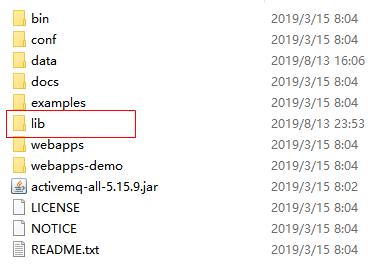
将下面几个Jar放入。

step4:启动ActiveMQ,查看结果
启动之后,打开mysql数据库,发现生成了三张数据表。

这样就成功了,每次生成消息之后,就会将消息的信息存储到这三张表中,消费之后,再删除信息。
- AMQ:基于文件存储,这种方式会把消息写入日志文件,并且是顺序存储方式,这种方式比JDBC方式要好,缺点是:会为每个Destination创建索引,占用大量磁盘空间。
配置方法
在 activemq.xml
配置文件中配置,更加详细参数请参考: https://activemq.apache.org/a...
。
<broker brokerName="broker" persistent="true" useShutdownHook="false">
<persistenceAdapter>
<amqPersistenceAdapter directory="数据存储目录" maxFileLength="32mb"/>
</persistenceAdapter>
</broker>
- KahaDB:这个5.4版本之后出现的 默认的持久化方式 ,与AMQ很相似,不同的是只为Destination创建一个索引。
配置方法
在 activemq.xml
配置文件中配置,更加详细参数请参考: https://activemq.apache.org/k...
。
<broker brokerName="broker">
<persistenceAdapter>
<kahaDB directory="数据存储目录" journalMaxFileLength="32mb"/>
</persistenceAdapter>
</broker>
- LevelDB:5.6版本后推出的新的持久化方式。这种比KahaDB更快,跟KahaDB类似,但是不是用自定义B数实现。 但是需要注意的是,目前官网已经不推荐使用这种方式,而是推荐使用KahaDB。
配置方法
在 activemq.xml
配置文件中配置,更加详细的参数请参考: https://activemq.apache.org/l...
。
<broker brokerName="broker" ... >
...
<persistenceAdapter>
<levelDB directory="数据存储目录"/>
</persistenceAdapter>
...
</broker>
8 ActiveMQ网络连接支持
Broker的网络配置主要有三种配置方法,分别是 静态配置、动态配置和主从配置。
8.1 静态配置
静态传输提供了一种硬编码机制,可以使用URI列表发现其他连接。使用此发现机制的连接将尝试连接到列表中的所有URI,直到成功为止。
在activemq.xml配置文件中配置。
<networkConnectors>
<networkConnector uri="static:(tcp://localhoat:61616)"/>
</networkConnectors>
配置语法
static:(uri1,uri2,uri3,…)?options
举例
static:(tcp://localhost:61616,tcp://remotehost:61617?trace=false,vm://localbroker)?initialReconnectDelay=100
uri的属性说明

8.2 动态配置
在activemq.xml配置文件中配置。
<networkConnectors>
<networkConnector uri="multicast://default"/>
</networkConnectors>
8.3 主从配置
Master-Slave模型是非常常见的,主从模型主要是为了防止一个网络节点出现问题而提出的,提高了稳定性。
在ActiveMQ中也是可配置的,我们可以在activemq.xml配置文件中进行相关配置。
<networkConnectors> <networkConnector uri="masterslave:(tcp://host1:61616,tcp://host2:61616,tcp://..)"/> </networkConnectors>
注意:Master-Slave方式的第一个url需要是master,其他是slave。
另外, NetworkConnector 节点 还有其他属性可以配置,具体详情可以查看官网: https://activemq.apache.org/n... 。
8.4 容错的客户端连接方法
在前面的客户端连接ActiveMQ的时候只是使用一个简单的url进行连接。
ActiveMQConnectionFactory activeMQConnectionFactory
= new ActiveMQConnectionFactory("tcp://localhost:61616");
但是,这种方式会出现一个问题,一旦这台ActiveMQ宕机了,就连接不上了,所以,有另外一种容错的方式,当一台出现宕机,可以连接上其他的机器,这样就不会出现问题了。
ActiveMQConnectionFactory activeMQConnectionFactory
= new ActiveMQConnectionFactory("failover:(tcp://localhost:61616,tcp://remotehost:61616)");
其他属性参数请参考: https://activemq.apache.org/f... 。
- 本文标签: CTO message remote dependencies Service 数据库 schema spring RocketMQ 配置 时间 ACE classpath 连接池 XML brokerName struct consumer NIO apr src root Mysql数据库 NSA 2019 CEO ActiveMQ 端口 一对多 Action description Connection 目录 id 安装 需求 Word 测试 索引 消息队列 Transport ip 开源 plugin cat lib web 模型 IDE junit 空间 JMS windows 参数 Property tar dataSource mysql Master map 代码 删除 协议 session 实例 queue maven final ORM 产品 client apache rabbitmq 数据 微服务 UDP 监听器 cmd list Persistence DBCP linux MQ sql API http ssl HashMap App producer db 开发 bean 压力 build java 数据存储目录 UI JDBC TCP 下载 tab value connectionFactory https Java类 IO 安全 core 站点 amqp 管理
- 版权声明: 本文为互联网转载文章,出处已在文章中说明(部分除外)。如果侵权,请联系本站长删除,谢谢。
- 本文海报: 生成海报一 生成海报二










![[HBLOG]公众号](https://www.liuhaihua.cn/img/qrcode_gzh.jpg)

